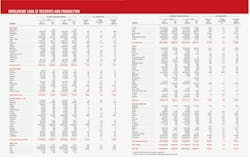2021 worldwide oil and gas reserves down, oil production up modestly
According to Oil & Gas Journal’s annual assessment, the world’s proved oil reserves total 1,724.5 billion bbl at yearend 2021, down from 1,727.5 billion bbl a year earlier. Worldwide proved natural gas reserves are now estimated at 7,254 tcf, down from 7,291 tcf in the previous year’s survey.
The published reserves figures rely on survey responses and official updates released by individual countries, which are not provided every year in many cases. OGJ changes its estimate for a country only when it receives evidence that a change is in order. Therefore, in a given reserves summary, a year-to-year change—or lack thereof—may not necessarily reflect a change that applies to the calendar year alone.
OGJ’s figures for oil reserves and production increasingly include natural gas liquids (NGL). Some countries’ gas reserves refer to dry gas reserves after moving NGL reserves explicitly into oil reserves.
When the original oil data are reported in metric tons, OGJ converted the data to volume unit b/d by applying conversion factors suggested by the International Energy Agency (IEA) for each country.
Driven by the rebound in oil demand and oil prices, global oil production is set to expand moderately in 2021. OPEC and its alliance (OPEC+) increased the pace of spare capacity normalization over the year.
OGJ forecasts global oil production in 2021 to average 88.45 million b/d vs. a 2020 average of 87.33 million b/d. Total OPEC oil supply is set to increase by 2.3% in 2021 to 30.83 million b/d. Prominent supply wildcards include Iran and Libya. Total non-OPEC production is expected to remain largely flat with the year-ago level, reflecting redefined capital allocation.
Reserves changes
According to OGJ’s assessment, total proven oil reserves in the Asia-Pacific region fell to 44.88 billion bbl in this year’s report from 46 billion bbl a year ago. Gas reserves fell to 566 tcf from 590 tcf.
The recently published 2021 China Mineral Resources Report (CMR) shows China’s remaining proven oil reserves at yearend 2020 totaled 3.62 billion tons, up from 3.55 billion tons at yearend 2019. China’s remaining reserves of natural gas were 6.26 trillion cu m at yearend 2020, up from 6 trillion cu m at yearend 2019. Coalbed methane reserves and shale gas reserves were 331.55 billion cu m and 402.62 billion cu m, respectively. During 2020, 2,956 wells were drilled in China for oil and gas exploration and the drilling footage reached 8,394.2 km, up 2.1% and 2.9% respectively from the year-ago levels. However, the total volumes of 2D and 3D seismic data acquired during the year decreased significantly.
According to the latest report from the Directorate General of Oil and Gas (DGOG), as of Jan. 1, 2020, Indonesia’s proven oil reserves totaled 2.44 billion bbl, compared to 2.48 billion bbl as of Jan. 1, 2019, and 3.15 billion bbl as of Jan. 1, 2018. The country’s proven gas reserves declined to 43.57 tcf as of Jan. 1, 2020, from 49.74 tcf a year ago.
India’s crude oil reserves slumped to 3.67 billion bbl as of April 2020, from 4.6 billion bbl as of April 2019, according to the Ministry of Petroleum and Natural Gas. Gas reserves also decreased by 22% to 38 tcf.
Geoscience Australia updated its assessments for Australia oil and gas reserves (2019 data) in 2021, the first update since 2015. According to the agency’s latest estimates, Australia’s proven oil (crude oil, condensate, and NGL) reserves were 1.8 billion bbl in 2019, down from the 2015 figure of 2.45 billion bbl. Proven natural gas reserves were 96.5 tcf, down from 114 tcf estimated in 2015.
In Western Europe, oil and gas reserves continue to decline dramatically in 2021, down 7% and 9% respectively.
According to data from the Norwegian Petroleum Directorate (NPD), at yearend 2020, Norway’s oil reserves, which include crude oil, condensate, and NGLs, amounted to 7.74 billion bbl, down from 8.12 billion bbl a year ago. Norway’s gas reserves declined to 50.8 tcf at yearend 2020 from 54.5 tcf at yearend 2019. The method NPD uses for classification of reserves is the United Nations Framework Classification System (UNFC).
The latest estimates from the UK Oil & Gas Authority show that UK’s proved oil reserves at yearend 2020 decreased to 2 billion bbl from 2.5 billion bbl at yearend 2019. Proven gas reserves also decreased dramatically by 27% to 4.64 tcf.
According to the Geological Survey of the Netherlands, the country’s estimated natural gas reserves, as of Jan. 1, 2021, decreased to 3.26 tcf from 4.68 tcf recorded as of early 2020. The country’s oil reserves, as of Jan. 1, 2021, were 73 million bbl, down sharply from 137.7 million bbl evaluated a year ago. The decline was due to re-evaluation of previously proven accumulations and production during 2020.
France’s oil and gas reserves both doubled in 2020, which reflected the reassessment by all operators of their reserves, according to the Professional Petroleum Committee (CPDP).
The Canadian Association of Petroleum Producers (CAPP) hasn’t updated its evaluation on Canadian oil and gas reserves at the time of this writing.
According to Pemex’s hydrocarbon annual evaluations, as of Jan. 1, 2020, Mexico’s estimated proved reserves of oil totaled 5.99 billion bbl, up from 5.78 billion bbl as of Jan. 1, 2019. The current oil reserves consisted of 5.65 billion bbl of crude and condensate, and 348 million bbl of NGL. Mexico’s proved dry gas reserves total 6.89 tcf, up from 6.38 tcf a year ago.
The latest estimates of Brazilian National Petroleum Agency (ANP) show that crude oil reserves in Brazil decreased for a second consecutive year to 11.89 billion bbl in 2020 from 12.71 billion bbl in 2019. The country’s gas reserves declined to 11.94 tcf from 12.85 tcf a year ago.
According to the Argentinian Institute of Oil & Gas (IAPG), Argentina’s proved crude oil reserves at yearend 2020 totaled 2.4 billion bbl, a 3% decrease from a year ago. Its proved gas reserves were largely flat with the year-ago level.
OPEC reserves
The reserve figures reported for OPEC members are referenced from the organization’s latest annual (2021) statistical bulletin.
Total proved crude oil reserves for the current OPEC group increased to 1,236.9 billion bbl from 1,226.5 billion bbl a year ago, and total natural gas reserves increased by 21.26 tcf to 2,604 tcf.
Saudi Arabia’s proven crude oil reserves increased to 261.6 billion bbl from 258.6 billion bbl a year ago while its natural gas reserves dropped by 10.5% to 298 tcf.
The United Arab Emirates (UAE)’s proven crude oil reserves increased by 9.2 billion bbl to 107 billion bbl and its natural gas reserves grew by 27% to 272.8 tcf. UAE found major oil reserves in Abu Dhabi during 2020, according to the country’s Supreme Petroleum Council (SPC). These additions marked a historic milestone for the country since the last major update of its reserves base three decades ago.
Angola’s crude oil reserves decreased by 7% to 7.2 billion bbl and the country’s natural gas reserves decreased by 12.2% to 10.63 tcf.
The current OPEC group’s oil reserves account for 71% of the worldwide total and gas reserves account for 35% of the world’s overall gas reserves.
US reserves
The decline in oil and natural gas prices in 2019 interrupted the upward trend of proven oil and natural gas reserves in the US. The proven reserves of crude oil and condensate in 2019 were basically the same as in 2018, and the proven reserves of natural gas fell by 2%, according to the latest Reserves Report (January 2021) from US Energy Information Administration (EIA).
Although the extensions and discoveries of proven crude oil and natural gas reserves in the US in 2019 were sufficient to replace annual production, the reserves were revised downwards due to falling prices.
Proved reserves of crude oil increased by 367 million bbl in 2019, proved reserves of leased condensate decreased by 313 million bbl, and overall, proved reserves of crude oil and condensate increased by 54 million bbl (0.1%) to 47.1 billion bbl at end 2019. US proved reserves of oil in 2019 remain at the record level.
Alaska added 259 million bbl of proven reserves of crude oil and condensate in 2019, the largest net increase of any state. New Mexico had the second largest net increase in proven crude oil and condensate reserves in 2019 (+226 million bbl), and Texas had the third largest net increase (+179 million bbl). The Permian basin in eastern New Mexico and western Texas contributed the most to these annual gains. Colorado saw the largest net decrease (-154 million bbl) in proved reserves of crude oil and condensate in all states in 2019.
Proved natural gas reserves (wet after lease separation) in the US fell by 1.9% to 494.9 tcf at end 2019 from 504.5 tcf at end 2018. This is the first annual decline in proven natural gas reserves in the US since 2015, but reserves remain at the second highest level in history.
Proven reserves of shale natural gas increased to 71% of the US total at end 2019 from 68% in 2018. The largest net increase in proven natural gas reserves in 2019 was in Ohio (+10.4 tcf). The largest net decrease was Texas (-12 tcf). The net downward revision of Eagle Ford, Barnett, and Bossier shale reserves contributed the most to the annual decline.
Meanwhile, the estimated volume of natural gas plant liquids (NGPL) contained in proved reserves of total natural gas decreased to 21.7 billion bbl in 2019 from 21.8 billion bbl in 2018, a 0.9% decrease. Proved reserves of dry natural gas in the US decreased to 465.4 tcf in 2019 from an estimated 474.8 tcf in 2018, a decrease of 2%.
EIA is scheduled this December to update the yearend 2020 estimates of proved reserves. As OGJ went to press at end November, the figures were unavailable. OGJ made its estimates based on reserves information revealed by the OGJ150 group.
OGJ estimates that, as of yearend 2020, US proved oil reserves, including crude oil, lease condensate, and NGL reserves, totaled 60.5 billion bbl, down 12% from the prior year, reflecting lower commodity prices. Dry natural gas reserves decreased 7% to 432 tcf. OGJ will update yearend 2020 US reserves to EIA’s figures in next year’s report.
World oil production
Thanks to the recovery of oil demand and oil prices, global oil production for 2021 will have expanded modestly. OGJ forecasts global oil production (excluding biofuels and processing gains) to average 88.45 million b/d for 2021, compared to an estimated average of 87.33 million b/d for 2020.
OPEC+ accounts for most of the gains. In 2020, OPEC+ reduced production by a record 9.7 million b/d as demand collapsed due to the pandemic. In April 2021, with improving oil demand and the drop in the global supply glut, OPEC+ decided to return 2.1 million b/d of supply to the market during May through July. In July 2021, OPEC+ agreed to continue phasing out output cuts by 400,000 b/d on a monthly basis starting August 2021.
Total OPEC oil supply is estimated to average 30.83 million b/d for 2021, compared to 30.15 million b/d last year. Saudi Arabia’s production is expected to decline slightly by 120,000 b/d to 10.6 million b/d. UAE’s production is expected to decline by 100,000 b/d, or 3%, to 3.66 million b/d. Iran and Libya, both exempt from official OPEC+ cuts, are the prominent supply wildcards. Buoyed by the formation of the interim Government of National Unity, Libya’s production is expected to surge to 1.3 million b/d in 2021 from 418,000 b/d last year. Iran’s oil supply is set to surge in 2021 by over 16% to 3.1 million b/d.
As part of the OPEC+ group, Russia’s total oil production is expected to average 10.68 million b/d this year, up 2% from the year-ago level of 10.47 million b/d. Kazakhstan and Azerbaijan’s production are largely flat with year-ago levels.
While stronger oil prices are prompting some US producers to pump more, US crude oil production is still expected to lag behind pre-COVID rates until the end of next year. Moreover, US oil production was damaged by a cold snap in February and Hurricane Ida in August and September. Combined, US crude oil production is expected to dip to 11.13 million b/d in 2021 from 11.28 million b/d last year. However, US NGL production is expected to increase to 5.36 million b/d in 2021 from 5.17 million b/d last year, offsetting the decline in US crude oil production. Total US oil supply is projected to increase slightly to 16.49 million b/d this year from 16.46 million b/d in 2020.
Canadian oil supply is expected to increase 5.3% in 2021 to 5.4 million b/d, supported by higher oil prices and new takeaway capacity. However, Canada’s offshore sector is expected to see the first annual decline in 6 years in 2021.
Brazilian oil production is expected to decrease slightly to 3.03 million b/d in 2021, due to recurrent disruptions caused by COVID-19 operational challenges.
In Europe, Norwegian oil output is expected to expand by 2.5% to 2.1 million b/d this year with startup of Johan Sverdrup field. UK’s oil output is set to drop by 11.5% this year to 900,000 b/d, reflecting the full shutdown of the Forties pipeline in May and June.
Oil production in the Asia-Pacific region is expected to remain largely flat in 2021. China’s oil production for 2021 will increase 2.5% to 4.07 million b/d, thanks to strong investments. Australia’s production is set to decrease slightly this year.

Conglin Xu | Managing Editor-Economics
Conglin Xu, Managing Editor-Economics, covers worldwide oil and gas market developments and macroeconomic factors, conducts analytical economic and financial research, generates estimates and forecasts, and compiles production and reserves statistics for Oil & Gas Journal. She joined OGJ in 2012 as Senior Economics Editor.
Xu holds a PhD in International Economics from the University of California at Santa Cruz. She was a Short-term Consultant at the World Bank and Summer Intern at the International Monetary Fund.

Laura Bell-Hammer | Statistics Editor
Laura Bell-Hammer has been the Statistics Editor for the Oil & Gas Journal since 1994. She was the Survey Editor for two years prior to her current position with OGJ. While working with OGJ, she also was a contributing editor for Oil & Gas Financial Journal. Before joining OGJ, she worked for Vintage Petroleum in Tulsa, gaining her oil and gas industry knowledge.


